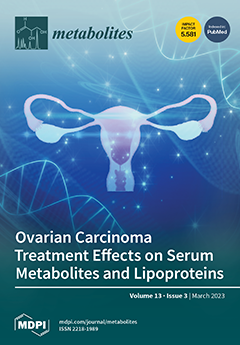From the rice fermentation product of a new record fungus,
Neohelicosporium griseum, two new polyketides, neogrisphenol A (
1) and neogrisphenol B (
2), one new isochroman-1-one, (
S)-6-hydroxy-7-methoxy-3,5-dimethylisochroman-1-one (
3), and four known compounds (
4–
[...] Read more.
From the rice fermentation product of a new record fungus,
Neohelicosporium griseum, two new polyketides, neogrisphenol A (
1) and neogrisphenol B (
2), one new isochroman-1-one, (
S)-6-hydroxy-7-methoxy-3,5-dimethylisochroman-1-one (
3), and four known compounds (
4–
7) were isolated. Their structures were determined using 1D- and 2D-NMR, mass spectrometry, and chemical calculations. The C-3~C-2′ polymerization mode between the two
α-naphthalenone derivative moieties is uncommon in compounds
1 and
2. Meanwhile, compounds
1–
2 and
5 exhibited antibacterial activity against
Bacillus subtilis,
Clostridium perfringens,
Staphylococcus aureus, and
Staphylococcus aureus, with MIC values ranging between 16 and 31 µg/mL. In addition, compound
5 showed antifungal activity against
Sclerotinia sclerotiorum and
Phytophthora nicotianae var. nicotianae, with respective IC
50 values of 88.14 ± 2.21 µg/mL and 52.36 ± 1.38 µg/mL. Compound
1 showed significant cytotoxicity against A2780, PC-3, and MBA-MD-231 cell lines with respective IC
50 values of 3.20, 10.68, and 16.30 µM, and the cytotoxicity against A2780 cells was even higher than that of cisplatin (CDDP). With an IC
50 value of 10.13 µM, compound
2 also exhibited cytotoxicity against A2780. The in vitro results showed that compound
1 inhibited A2780 cell proliferation, induced apoptosis, and arrested the cell cycle at the S-phase in a concentration-dependent manner.
Full article






